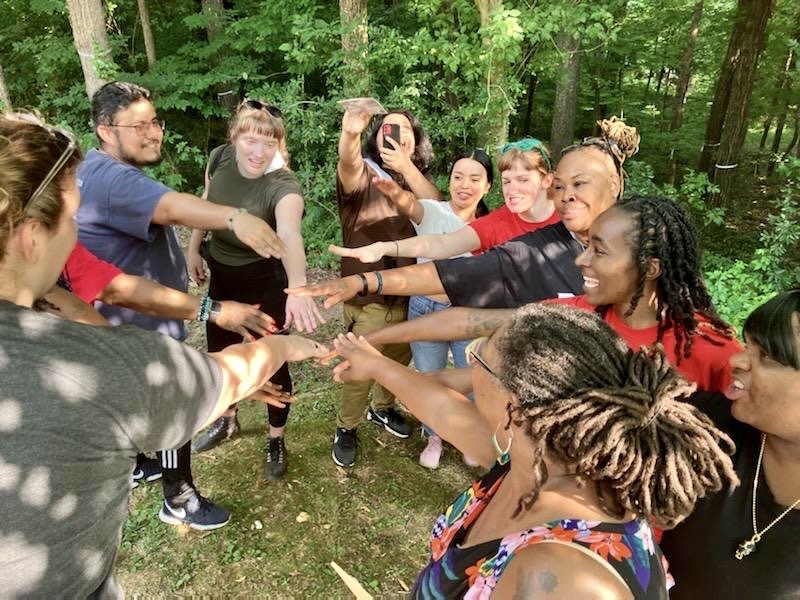I was born in Buffalo, New York a few years before the steel plants were shut down. Almost overnight, over 30,000 people lost their jobs with little to no safety net or plan to take care of workers. As in many rust belt towns, the steel plants had provided jobs as well as a deep sense of identity for generations. Growing up, I remember hearing stories about who was to blame for the final nail in the coffin of steel: people of color. As corporate executives closed the doors on the plants, they employed strategic racism to direct blame towards Black people and immigrants rather than those at the top who walked away from the folding industry even richer, as the surrounding community fell into economic despair.
Thirty years later, a white supremacist walked into the only grocery store in a historically redlined Black neighborhood and murdered ten people. White resentment is deadly, it is powerful, and it has been stoked by the Right across generations. To adequately address the challenges our movements face in this time, we need to name it as the fuel for the Right’s dramatic rise in the last two decades.
At Showing Up for Racial Justice (SURJ), where I have been director for the past five years, we undertake the work of undermining the Right’s white radicalization pipeline and out-organizing them in white communities. This is a key part of our contribution to the pro-democracy movement.
SURJ was founded in 2009 after the Tea Party turned large swaths of working white people against the Affordable Care Act through strategic racism. Now, looking down the barrel of the next 17 months until the 2024 presidential election, we are focusing our work on mobilizing white people in key swing states to stop an authoritarian takeover of the federal government, while also expanding our base of white working people in the South to contribute to building multiracial democracy and progressive power beyond Election Day.
To accomplish these things, we don’t need all the white people –– but we need more than we have now.
Why White People? And Which Ones?
While demographics are shifting, white people still comprise a racial majority in many parts of this country. Nearly any strategy outlined to build a united front to defeat fascism at the federal level in 2024, and then to build our movement’s power beyond that, will necessitate a large group of white people coming with us. And we believe it’s important to name the elephant in the room: when we’re talking about our opponent’s base, we’re almost entirely talking about white people.
The Right is very clear on its messages to white people: the Left hates you, the system is rigged against you, and the “takers” are getting everything while you struggle. In recent years, their strategy has expanded from racially coded dog whistles to attacks on “the woke agenda,” which include demonizing queer people and other social minorities along with people of color. These fear tactics rely on ideologies like “the Great Replacement Theory,” of which the Buffalo shooter was a proponent, and the belief that everyone except white people is getting special treatment while whites get left out to dry.
The Right’s strategy in mobilizing white communities is effective. And so our strategies to out-organize them must be equally sharp. Like any racial group, white people are not a monolith and different constituencies require different tactics and different on-ramps.
For one strategic sector of white people we organize at SURJ, this means refocusing their antiracist work away from individual learning and practice and into collective action that builds power. For over a decade, we’ve welcomed white people who have woken up to the horror of racism into a political home where they understand anti-racism as a practice of collective action, not just learning. We are building a base of leaders across the country who participate in our campaigns and find belonging in our national work.
For another sector, this means being organized away from the strategic white solidarity employed by the far Right and toward multiracial solidarity –– seeing their common cause and shared interest in joining ranks with working people of all races instead of the white elite.
We do not work to de-radicalize the MAGA base. Instead, we focus on those working-class white communities the far Right is also targeting: people who could go either way, with us or with them. From pollution disasters like that in East Palestine to a growing cost of living, the right loudly and publicly lays blame on anyone but those at the top. It’s our work to place blame where it belongs without falling prey to a race-blind class analysis.
Organized Around What?
To this point, in their piece published earlier this year in Convergence, Erica Chenoweth and Zoe Marks warn of a potential drift towards centrist or moderate politics as we work to build a “big tent” to resist fascism.
This centrist drift is especially tempting in organizing white people, and we’re losing because of it. Centrist branches of the Democratic party and other liberal elites wring their hands and avoid talking about race so as to not isolate white people. Clearly, this approach is not strategic for our long-haul project of building the power of our multiracial working people’s movement. But it also doesn’t win in the short term. While the MAGA right talks about race constantly and uses it as a key part of their strategy, race-avoidant liberals are losing ground.
And in truth, the Right is able to fan the flames of white resentment so effectively in part because, in the interest of centrist politics, so-called progressives tell people things will be better if we just elect this candidate or pass that policy. People know better. In the face of real human suffering, we owe it to people to be real about how the system is failing them, but talk about a different reason for the “why.”
A shared interest organizing approach in working class white communities is SURJ’s “why.” We meet people in their suffering, name race and how it is used by those in power, and identify who benefits when working people stay divided.
For example, after the summer of uprisings in 2020, our chapter in Louisville launched a campaign to end cash bail and canvassed primarily white working-class neighborhoods using a shared interest frame relating incarceration and poverty. In these conversations, we gave white people the space to process their authentic experiences living in Louisville, one of the epicenters of a global racial justice uprising, and built connections with them around the Black-led demand to end cash bail in the city and how it related to the criminalization of poverty.
Last year, the chapter endorsed 13 local judge candidates who they identified as anti-cash bail or movable. 7 of those candidates won with high support in the white working-class neighborhoods that we had been canvassing all year. In our conversations, 75% of white working-class voters we spoke with agreed that we needed to end cash bail, not just reform it, because so many have had a personal experience with cash bail or know someone who has. Roughly half of them were registered Republicans.
Building Towards the 2024 Election– And Beyond
At the beginning of this year, SURJ went through a strategic planning process that resulted in our three-year national strategy to build the white flank of our pro-democracy movement. In this time, our leadership wrestled with many of the questions outlined in the 22nd Century paper: how to bring white working communities into a shared multiracial identity, how to create polarization moments for white people at the scale and impact of the far Right, and how to grow at both the necessary scale and depth to block our opponents and win our agenda.
Like many addressing the conditions of this moment, we agree that while relying solely on elections will ultimately not achieve the aims of our movement, contending for electoral power is a critical part of blocking the rise of authoritarianism. White communities have an out-sized influence on elections because of the very setup of our country’s political systems in the Electoral College and the Senate. The GOP knows this, uses it to their ends, and Republican leaders like Trump have publicly acknowledged that if more people were involved in elections, they’d lose. As stated above, they rely on white support, so a key strategy in undermining their success is out-organizing them in the constituencies they target.
In our work, organizing white communities around shared interest has worked in a variety of geographies and issues from blocking a near-total ban on abortions in Kentucky to engaging nearly 40,000 white Georgians to contribute to the multiracial coalition that defeated Trump in 2020. Now the task is to do that at scale in strategic races.
In 2024, we will focus on federal races in Ohio and Wisconsin, majority white states where white working-class communities are targeted for radicalization by the far right, as well as the more racially diverse states of Georgia and North Carolina where we’ll work to run up the numbers of white people in rural counties to contribute to the flourishing multiracial coalitions working to win.
This year, we’re working backwards from those elections in 2024 to hone our organizing strategies, grow power in those priority states, and build up member leadership. To do this, we’re running a national distributed program focused on school board races and school policies like defending anti-racist curriculum and resisting the enforcement of anti-trans legislation. We’re also bringing in members from within Kentucky and from across the country to help re-elect Governor Andy Beshear, one of two Democrats to hold a Governor’s office in the South, and one of the only high-profile races this year. Both of these campaigns –– schools and Governor Beshear’s race –– are a practice in a block and build, nationally-fueled and locally-led organizing model.
As we work to block the far Right’s electoral gains and build our member base along the way, we continue to grow our local projects based in small towns and rural communities in the South. After planting a small town organizing project fighting for renter’s rights outside of Nashville in 2017, we are growing that work into a statewide coalition to bring poor white renters into campaigns fighting for housing justice. One year ago, we launched a similar project in rural Eastern Kentucky. In Georgia, we are canvassing and calling rural areas that have been affected by hospital closures to identify campaigns and bring people into healthcare fights.
Giving White People a Better Option
Earlier this year, when the Tennessee Four were ousted from the statehouse for standing in solidarity with students protesting gun violence, a leader in our rural Tennessee work said, “This never would have happened if we had projects like ours all across the state.” Our small town Tennessee work does not begin with electoral politics, but when we meet people in their suffering and bring them into campaigns that win citywide renters’ committees, like we did in her town, these areas become inoculated against the racist scarcity messaging of the far Right.
This work is nuanced, humbling, and experimental. Organizing poor white people into multiracial formations at scale without falling prey to the class reductionism that ignores race is something we on the left have not cracked yet. We are not the only ones working in this lane and we are not the first to be. We are moving this work forward with the lessons of the past and alongside other organizations with missions like ours and a shared vision for the future.

